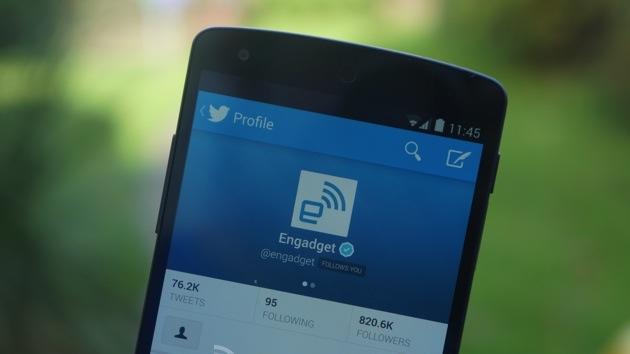University of Sheffield
Latest

Will we be able to control the killer robots of tomorrow?
From ship-hunting Tomahawk missiles and sub-spying drone ships to semi-autonomous UAV swarms and situationally-aware reconnaissance robots, the Pentagon has long sought to protect its human forces with the use of robotic weapons. But as these systems gain ever-greater degrees of intelligence and independence, their increasing autonomy has some critics worried that humans are ceding too much power to devices whose decision-making processes we don't fully understand (and which we may not be entirely able to control).

Researchers are working on a lie detector to sniff out false tweets
Sure, some less-than-true statements on Twitter are innocuous, but the social media network's vast audience means it has huge potential to spread inaccurate, even dangerous, information. Citing examples like the 2011 London riots and accusations of vote-rigging during Kenyan elections, researchers at the University of Sheffield have introduced the concept of a lie detector to analyze information shared on Twitter and other sites. The EU-funded project, dubbed Pheme, will sort online rumors into four categories: speculation, controversy, misinformation and disinformation. Additionally, Pheme will evaluate sources to determine their authority; tweets from the BBC would hold more weight than an unverified user's, for example. The system will also search for sources to confirm or deny information in a tweet, following social media conversations about a given topic to eventually determine what's true and what's false. Hypothetically, users would be able to view info about a rumor's accuracy via a virtual dashboard. To test out of the project, scientists will be running trials with the Swiss Broadcasting Corporation and the Institute of Psychiatry at King's College London. Clearly, Pheme's goal is to verify news on a national and even international scale -- so your Twitter fibs about amazing weekend plans are safe, for now.

External voice box prototype helps cancer, stroke sufferers regain speech
A team of UK scientists has developed a headset that can bring voices back to those who have lost their speech due to injury, cancer, stroke, and other maladies. They hope the prototype -- which uses magnets positioned in the user's mouth or tongue -- will take the place of low-tech solutions like throat valves, which have the tendency to get clogged. When he or she speaks, changes to the magnets' movements are detected by the device, which associates specific facial movements with corresponding words (the device currently has a vocabulary of about 50). The whole thing is still pretty clunky, as evidenced by the image at right, but the researchers are working on cramming the technology into a device roughly the size of a Bluetooth headset. They're also working on a way to implant magnets into the tongue of the wearer -- positioning the magnets in the wearer's mouth is proving to be one of the largest difficulties in implementing the technology.

New biggest star discovered, is not Justin Bieber
You know how sometimes you're just sitting out in a field with your homies, looking up at the stars and thinking man, the universe is so BIG... and I'm just so small! Thanks to the Very Large Telescope in Chile, Professor Paul Crowther at Sheffield University, and some good old-fashioned Hubble data, you can feel just a little bit smaller. Crowther and his team have measured the giant known as R136a1 to be 265 times the size of the sun. That's a pretty cool size, but not quite as cool as the 320 solar masses it was at birth -- nothing to sneeze at, since previous discoveries had the largest stars somewhere around 150 solar masses. It's also the most luminous star ever found, at 10 million times brighter than the sun. Even so, don't get your hopes up trying to see this with your telescope (unless it's, you know, Very Large) because it's a good 165,000 light years away. Doesn't mean you can't look in its direction and smile, though. [Image: ESO / M. Kornmesser]

Microscopic wheel will spin straight to your heart, literally
Sure, you've got an iPod Nano in your pocket and a VIA Nano in your custom PC, but we're willing to bet you don't have any nanomachines in your arteries at the moment. Two scientists from the Universities of Sheffield and Barcelona, Ramin Golestanian and Pietro Tierno, hope to change that by turning your bodily fluids into pathways for their tiny devices. The things are comprised of two beads, measuring 1 and 3 micrometers, attached to each other using strands of DNA. A magnetic field gets 'em spinning in the right direction and the increased surface area of the larger bead moves the contraption forward at a blistering 1 micrometer per second (shown in a short but sweet video below). Now, if the good doctors could just build 11 of these things and get them in a 4-3-3 formation we'd finally know where to place our money for next year's nanosoccer RoboCup Open.[Via Scotsman.com]

Anton the robotic tongue has saved you from electrode doom
So we had a choice: either we let scientists at the University of Sheffield attach electrodes to our tongues, or they were going to go and build their own artificial mouth. Because we're not so into the whole electrode thing, they built "Anton," an animatronic tongue made of soft silicone to help them understand speech and subsequently improve speech-recognition software. This isn't the first of its kind, believe it or not -- there's much competition in the robotic mouth world. Because speech recognition systems aren't really benefiting from simply crowding them full of recorded speech, researchers want to better understand how the mouth produces sound and then create algorithms that can simply recognize speech patterns rather than try to match recordings to recordings. Sounds about right to us. Peep the creepy video after the break.





